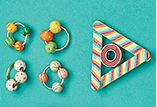Teach engineering skills by building fidget spinners in the classroom.
A New Spin on STEM
You hate them. Kids love ’em. Meet in the middle by turning fidgets into a teaching moment.
These handcrafted versions add pizzazz to your STEM studies, and they help students hone their engineering skills, develop fine-motor reflexes, and learn to recognize and manipulate geometric shapes. After kids have finished their projects, consider creating a chart about how and when to use fidgets responsibly, such as during morning meetings or mini-lessons, or while
watching videos. Here are three fun fidgets to get you started!
Fidget Spinner
What You Need: Mini craft sticks, gel or paint pens, washi tape, skateboard bearings, superglue, machine nuts
What to Do:
1 | Have each student decorate three mini craft sticks with gel or paint pens.
2 | Place the three decorated craft sticks around a skateboard bearing, and use superglue to adhere the overlapping craft stick ends. Make sure the bearing is snug in the center.
3 | Once the glue on the ends is dry, superglue the bearing to the craft sticks at the three points of contact.
4 | Wait for the glue around the bearing to dry, and then glue one machine nut to the bottom of each of the three corners. The machine nuts will add weight to the spinners and increase their momentum when spun on a surface.
Fidget Ring
What You Need: Wooden beads, 1″ key rings
What to Do:
1 | Select beads with holes large enough to accommodate a 1″ key ring. Give each student three wooden beads and one key ring.
2 | Have students decorate their beads using gel pens or paint pens.
3 | Slide the beads onto the key ring and snap it closed.
Stress Ball
What You Need: Plastic soda or water bottles, scissors, baking soda, hair conditioner, balloons, wooden dowels or chopsticks
What to Do:
1 | Have students create a funnel by cutting the top off of a soda or water bottle.
2 | Mix together the baking soda and hair conditioner. Each student will need one box of baking soda and ½ cup of hair conditioner. Have students use their hands to knead the mixture.
3 | Pass out 9″ or 12″ balloons. Each student should secure the balloon’s opening around the mouth of their bottle-funnel. Next, place the baking soda/mixture in the funnel, and carefully use a dowel or wooden chopstick to push it into the balloon.
4 | Remove the balloon from the funnel and tie off the end.
